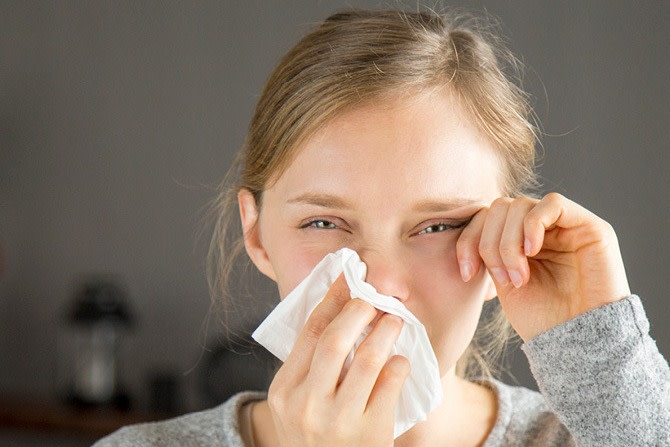Buy One, Get One 50% OFF Eyeglasses
* Restrictions apply. Ask a Team Member for details.
Types of Eye Allergies and Treatments

Eye allergies can be a seasonal problem or a year-round one. It can be frustrating when allergies disrupt your vision and irritate your eyes.
eyecarecenter is a trusted name in local vision care. Founded in 1954, our highly trained eye doctors help North Carolinians see more clearly. Our doctors have some insight into what seasonal allergies your symptoms might match and what at-home treatments you could try.
At-Home Remedies for Allergies
Most allergies have common treatments that should relieve any discomfort.
Common Treatments for Allergies
Common short-term at-home treatments for allergies can include:
Artificial Tear substitute eye drops
Reducing exposure to indoor and outdoor allergens, depending on your allergy
OTC decongestants and antihistamines; allergy shots, oral antihistamines
In the specific cases of Vernal Keratoconjunctivitis, Atopic Keratoconjunctivitis, and Giant Papillary Conjunctivitis, you can treat them at home by taking a break from wearing your contacts as well as avoiding allergens. Prescription eyedrops are reliable relief for these types of allergies as well. If at-home remedies are not providing relief, talk to your eye doctor about treatments they can offer.
Pataday Eye Drops for Allergy Symptoms
If you're looking for eye drop solution recommendations, the highly-trained eye doctors of eyecarecenter can help. The doctors at eyecarecenter recommend Pataday, a brand of eye drops that treat allergies. Pataday specifically treats redness and itchiness, so you can continue to enjoy your day without irritation.
6 Types of Eye Allergies
If you often get eye allergies, you may have one of the following types. If your symptoms continue after you've tried our various at-home remedies, it might be time to see an eye doctor.
Seasonal Allergic Conjunctivitis
Seasonal Allergic Conjunctivitis (SAC) occurs seasonally in the spring, summer, or fall. A SAC reaction depends on the type of plant pollen in the air. The most common plant pollens that cause a SAC reaction are grass pollen and ragweed.
Symptoms
Symptoms of SAC can include:
Itching
Redness
Burning
Clear, watery discharge
Dark circles
Puffy eyes
Sensitivity to light
Perennial Allergic Conjunctivitis
Perennial Allergic Conjunctivitis (PAC) is similar to SAC, except it occurs year-round. PAC has different causes from SAC, which are more common.
Symptoms
Dust mites
Mold
Pet dander
Other household irritants
In addition, PAC exhibits mild symptoms similar to those of SAC.
Contact Allergic Conjunctivitis
Contact Allergic Conjunctivitis occurs from irritation from using contact lenses. Irritation happens when the proteins from your tears collect on the surface of the lens.
Symptoms
Itching
Redness
Lens Discomfort
Mucous discharge
Vernal Keratoconjunctivitis
Vernal Keratoconjunctivitis is an eye allergy with more severe symptoms than SAC or PAC. It most likely occurs year-round but can significantly worsen as the seasons change. This type of allergy most commonly occurs in boys and young men, and 75% of patients also have eczema or asthma.
Symptoms
Itching
Significant increase in tear production
Increase in mucus
Feeling that something is stuck in your eye (foreign body sensation)
Light sensitivity
Atopic Keratoconjunctivitis
Atopic Keratoconjunctivitis mainly occurs in older patients, especially men prone to allergic dermatitis. It can happen year-round and has similar symptoms to Vernal Keratoconjunctivitis. This allergy can cause cornea scarring if left untreated.
Symptoms
Severe itching
Burning
Redness
Significant increase in mucus production
Giant Papillary Conjunctivitis
Giant Papillary Conjunctivitis is a more severe form of Contact Allergic Conjunctivitis. This most commonly occurs when people wear contact lenses, specifically soft lenses. Other allergens, especially chronic allergies, can also contribute to the allergy.
Symptoms
Symptoms most commonly affect the inside of your eyelid.
Eyelid symptoms:
Roughness
Redness
Swelling
Formation of bumps
Eyeball symptoms:
It feels like something is in your eye
Redness
Itchiness
Excess mucus
Blurry vision
Feeling that your contact is moving
Book Your Eye Exam at eyecarecenter
Can't find eye allergy relief at home? Make sure that you book an appointment with your nearest North Carolina eye specialist at eyecarecenter today. Relief is just a call or click away!